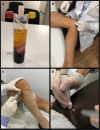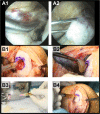The Clinical Use of Biologics in the Knee Lesions: Does the Patient Benefit?
- PMID: 31254255
- PMCID: PMC6684695
- DOI: 10.1007/s12178-019-09573-3
The Clinical Use of Biologics in the Knee Lesions: Does the Patient Benefit?
Abstract
Purpose of review: Overview the outcomes of the latest use of platelet-rich plasma (PRP) for the treatment of knee lesions in the clinics and discuss the challenges and limitations.
Recent findings: Recent clinical studies mainly indicate there may be benefit of PRP usage for the treatment of knee lesions. As an autologous source of bioactive components, PRP has been shown to be typically safe, free of major adverse outcomes. The use of PRP has been continuously increasing, and some well-designed, double-blinded, placebo-controlled clinical trials have been published. Clinical outcomes relating to PRP usage are multifactorial and depend on the severity of the lesion and patient characteristics. Although PRP is safe to use and it can be easily applied in the clinics, case-specific considerations are needed to determine whether PRP could be beneficial or not. If the use of PRP is favored, then, the configuration/optimization of the preparation and administration/delivery strategy with or without a concomitant treatment may further enhance the clinical outcomes and patients' experience.
Keywords: Biologics; Knee; Ligament; Meniscus; Osteoarthritis; Platelet-rich plasma.
Conflict of interest statement
The authors declare that they have no competing interests.
Figures


Similar articles
-
The effectiveness of leucocyte-poor platelet-rich plasma injections on symptomatic early osteoarthritis of the knee: the PEAK randomized controlled trial.Bone Joint J. 2022 Jun;104-B(6):663-671. doi: 10.1302/0301-620X.104B6.BJJ-2021-1109.R2. Bone Joint J. 2022. PMID: 35638203 Clinical Trial.
-
Allogenic platelet-rich plasma for treatment of knee and hip osteoarthritis.Front Pain Res (Lausanne). 2023 Jun 15;4:1216190. doi: 10.3389/fpain.2023.1216190. eCollection 2023. Front Pain Res (Lausanne). 2023. PMID: 37396144 Free PMC article. Review.
-
Can platelet-rich plasma enhance the effect of meniscus repair? A meta-analysis of randomized controlled trials Platelet-rich plasma and meniscus repair.J Orthop Surg (Hong Kong). 2022 Sep-Dec;30(3):10225536221131483. doi: 10.1177/10225536221131483. J Orthop Surg (Hong Kong). 2022. PMID: 36278428
-
Efficacy of intra-articular injection of allogeneic platelet-rich plasma for knee osteoarthritis combined with hematologic blood dyscrasias with platelet dysfunction: protocol of a randomized, double-blind, placebo-controlled trial.BMC Musculoskelet Disord. 2022 Dec 14;23(1):1095. doi: 10.1186/s12891-022-06073-3. BMC Musculoskelet Disord. 2022. PMID: 36517775 Free PMC article.
-
Platelet-Rich Plasma Versus Hyaluronic Acid for Knee Osteoarthritis: A Systematic Review and Meta-analysis of Randomized Controlled Trials.Am J Sports Med. 2021 Jan;49(1):249-260. doi: 10.1177/0363546520909397. Epub 2020 Apr 17. Am J Sports Med. 2021. PMID: 32302218
Cited by
-
Long head of the biceps as a local autograft for surgical treatment of high-grade acromioclavicular dislocations: a clinical anatomy and feasibility study.JSES Rev Rep Tech. 2025 Mar 8;5(3):389-394. doi: 10.1016/j.xrrt.2025.02.003. eCollection 2025 Aug. JSES Rev Rep Tech. 2025. PMID: 40697291 Free PMC article. No abstract available.
-
Platelet-Rich Plasma: New Performance Understandings and Therapeutic Considerations in 2020.Int J Mol Sci. 2020 Oct 21;21(20):7794. doi: 10.3390/ijms21207794. Int J Mol Sci. 2020. PMID: 33096812 Free PMC article. Review.
-
Platelet-rich plasma-derived extracellular vesicles: A superior alternative in regenerative medicine?Cell Prolif. 2021 Dec;54(12):e13123. doi: 10.1111/cpr.13123. Epub 2021 Oct 5. Cell Prolif. 2021. PMID: 34609779 Free PMC article. Review.
-
Treatment of Partial Posterior Cruciate Ligament Injuries with Platelet-Rich Plasma in Growth Factors (PRGF) Intraligamentous Infiltration and a Specific Knee Brace.Surg J (N Y). 2021 Feb 28;7(1):e30-e34. doi: 10.1055/s-0040-1722342. eCollection 2021 Jan. Surg J (N Y). 2021. PMID: 33659640 Free PMC article.
-
Modifying Orthobiological PRP Therapies Are Imperative for the Advancement of Treatment Outcomes in Musculoskeletal Pathologies.Biomedicines. 2022 Nov 15;10(11):2933. doi: 10.3390/biomedicines10112933. Biomedicines. 2022. PMID: 36428501 Free PMC article. Review.
References
-
- Cengiz IF, Pereira H, Espregueira-Mendes J, Oliveira JM, Reis RL. Treatments of meniscus lesions of the knee: current concepts and future perspectives. Regen Eng Transl Med. 2017;3(1):32–50.
-
- Gomoll A, Filardo G, De Girolamo L, Esprequeira-Mendes J, Marcacci M, Rodkey W, et al. Surgical treatment for early osteoarthritis. Part I: cartilage repair procedures. Knee Surg Sports Traumatol Arthrosc. 2012;20(3):450–466. - PubMed
-
- Pereira H, Cengiz IF, Vilela C, Ripoll PL, Espregueira-Mendes J, Oliveira JM et al. Emerging concepts in treating cartilage, osteochondral defects, and osteoarthritis of the knee and ankle. Osteochondral Tissue Engineering. Springer; 2018. p. 25–62. - PubMed
-
- Vannini F, Spalding T, Andriolo L, Berruto M, Denti M, Espregueira-Mendes J, Menetrey J, Peretti GM, Seil R, Filardo G. Sport and early osteoarthritis: the role of sport in aetiology, progression and treatment of knee osteoarthritis. Knee Surg Sports Traumatol Arthrosc. 2016;24(6):1786–1796. - PubMed
Publication types
LinkOut - more resources
Full Text Sources
Research Materials

